|
Original etching for in L'Art
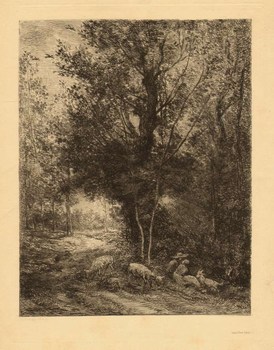 |
|
LE
BERGER ET LA BERGERE , 1874
(DELTEIL, MELOT 122)
Shepherd and Shepherdess) Etching, 1874.
Edition with letters as published in L’Art in 1874. Printed by
L.Fort
28 by 21
cm, Impression in a full sheet with small margins.
Price: 220
€ |
|
Two
large landscapes with cattle
|
|
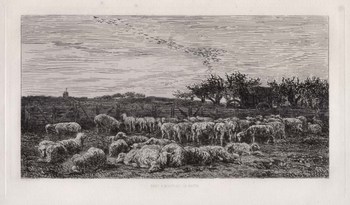 |
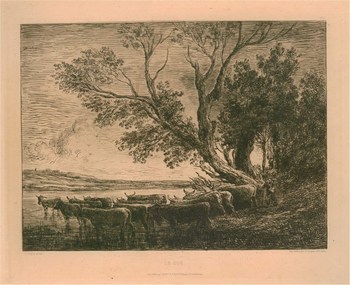 |
|
PARC A MOUTON LE MATIN, 1860
The theme reflects Daubigny's interest in the rendering of the
atmospheric affects of landscape. A painting of this subject was
exhibited at the Paris Salon of 1861 and Daubigny also executed a
"cliché-verre" version in 1862. This state of the etching appeared
with the title "Parc a mouton le matin" in the first volume of "Eaux-fortes
modernes" in 1862-1863.
Signed
Daubigny pinxt & sculpt bottom left
21,50 by 38,50 cm, Impression in a full sheet with 10 cm margins.
Price: 420 EURO
|
LE
GUE , 1865, tiré 1 janvier 1866
A group of cows passing the ford.
Some details remind the Dutch animal etchers from the 17th century's
Daubigny Sculp on the left
Imp. Delâtre, Rue St Jacques 303, Paris on the right
Paris published par Cadart & Luquet, Editeurs 79, Rue Richelieu in
the middle. Their oval dry stamp in the margin
30,50 by 37 cm, Impression in a full sheet with wide margins.
Price: 380 EURO |
|
A selection of fine etchings |
|
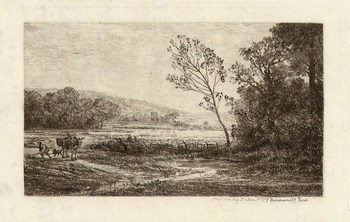 |
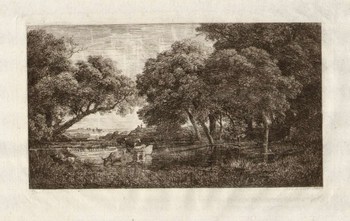 |
|
AUTUMN
(SOUVENIR OF THE MORVAN),
1850
Reference: Melot D 71, ( VIII / IX)
The
history of this etching is complicated. The design was almost completely
changed; Initially the man in the foreground was drinking from a stream,
in later state he transformed in a peasant with his mule and somecattle.
Published
by Delätre
15,60 by 26,40 cm on plate border, with nice margins.
Laid paper
Price: 220 EURO |
COWS IN
THE MARSH, 1851
Reference: Melot D 83, ( III / IVb)
This etching was executed
for the album of the second series of etchings. The success of the first
series in 1850 encouraged him to pursue his enterprise.
Published by Delätre
14,80 by 24,20 cm on plate border, with nice margins.
Laid paper
Price: 220 EURO |
|
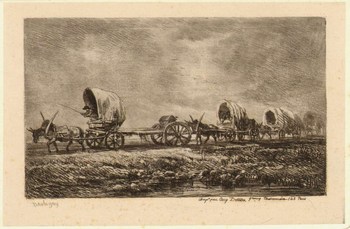 |
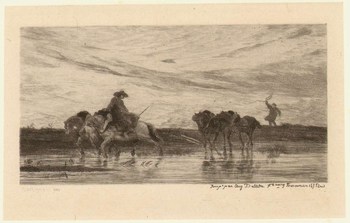 |
|
HAULAGE
WAGONS (SOUVENIR OF THE MORVAN), 1850
Reference: Melot D
76, ( IV / IV )
This etching made part of the first series of
etchings published by Daubigny in 1850. Since his success in 1848
Daubigny had become a painter of note. With the backing of men in high
positions in the Second Republic he went from success to success. The
etchings formed a way to expand his public.
Published
by Delâtre
11,80 by 18 cm on plate border, with nice margins.
On papier de Chine applied on woven.
Price: 185 EURO |
TWO
HORSES, 1850
Reference: Melot D
68, ( V / V )
As the one to the left, this etching makes also
part from the first series of etchings.
The drawing for this etching
was shown by Keppel in the exhibitions of the graphical works by
Daubigny in NY May 1 1907.
Published by Delâtre
8 by 15,70 cm on plate border, with
nice margins.
On papier de Chine applied on woven.
Price: 185 EURO |
|
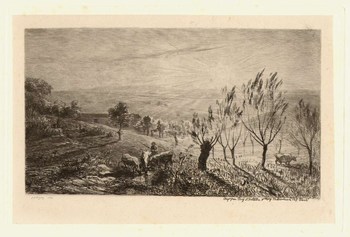 |
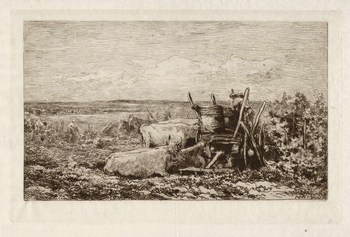 |
|
SUNRISE,
1850
Reference: Melot D 67, ( V / V )
Another one from
his first series of etchings,
this one a larger plate.
A very atmospheric work
Published by Delâtre
13,40 by 23,30 cm on plate border, with nice margins.
On papier de Chine applied on woven.
Price: 320 EURO |
THE
VINTAGE
(SOUVENIR OF THE MORVAN), 1865
Reference: Melot D 117, (
III / IV )
The second plate supplied to the société des
aquafortistes. Henriet identified it with the title: after a study
painted in the Morvan region. The engraving was exhibited in the Salon
of 1865.
Published by Delâtre
19,50 by 33,50 cm on plate border, with
nice margins.
On Japan paper.
Price: 220 EURO |
|
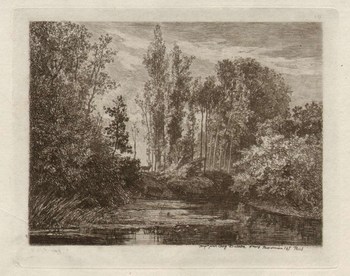 |
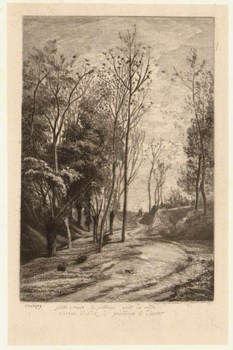 |
|
STAGS
AT THE WATERSIDE, 1850
souvenir of the islands at bezons
Reference: Melot D 78, (VII
/ VII )
Another example of a plate completely reformed before the
state with the bpublishers address. The first state with undetailled
masses in impressionist experiments like Pisarro executed. From the
fifth state completely different.
Published by Delâtre
13,50 by 17 cm on plate border, with nice
margins.
On Japan paper.
Price: 185 EURO |
THE
LITTLE BIRDS ,
1850
Reference: Melot D 70, ( III / IV )
Also from his
first series of etchings.
With two lines of a song of the time engraved beneath the subject.
Published by Delâtre
14,80 by 10 cm on plate border, with nice margins.
On papier de Chine applied on woven.
Price: 185 EURO |
|
Two special subjects
|
|
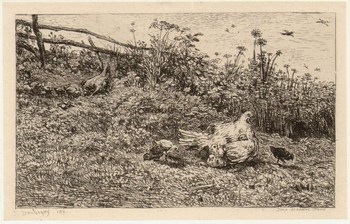 |
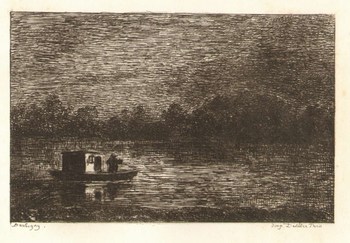 |
|
THE HEN
AND HER CHICKS,
1860
Reference: Melot D 97 (IV / IV)
A very nice
subject and fine etching.
Two states before any publishers address. Here with the address of
Delâtre/
9,40 by 15,30 cm on plate border, with nice margins.
On papier de Chine applied on woven.
Price: 220 EURO |
NIGHT
VOYAGE , OR NET FISHING, 1861
Reference: Melot D 109, (? /
II )
This state with the piublishers address of Delâtre is not described by
Melot.
Daubigny engraved this work a first time but due to a
crack of the varnish he could not publish it (D.108). So he re-engraved
it a second time. The print did not make part of a series as published
after 1850 by Daubigny. This print seems to be rather rare.
10 by
15,80 cm on plate border,
full sheet of woven paper with large margins.
Price: 220 EURO |
|
Four
original etching's published in Gazette des Beaux-Arts |
|
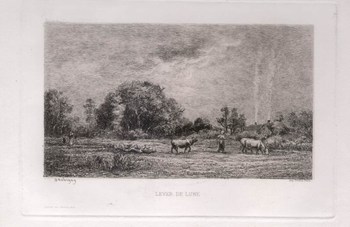 |
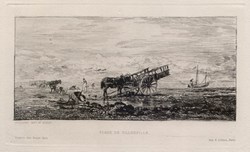 |
|
LEVER DE LUNE, 1871
Purity of line combined with striking atmospheric effects. It
both looks back to the seventeenth century landscape art of
Rembrandt and his contemporaries and forward to the
revolutionary movement of French Impressionism. Lever de
Lune was actually commissioned by the Gazette des Beaux-Arts in
1861. However, apart from a handful of trial and working proofs
which constitute the initial states, the first full edition was
not published by the Gazette until 1871.
Signed Daubigny bottom left, Imp. Delâtre Paris at right.
13,50 by 19,50 cm on plate border in a full sheet with nice margins.
Price: 220
EURO
|
PLAGE
DE VILLERVILLE,
Delteil
et Melot 88 - iv/v
A
fourth state, as published in the Gazette de Beaux
Arts in 1874.
Signed
Daubigny invent et Sculp left, Imp. A Salmon Paris
at right.
15 by 22 cm on plate border in a full sheet with
nice margins.
Price: 200 EURO
|
|
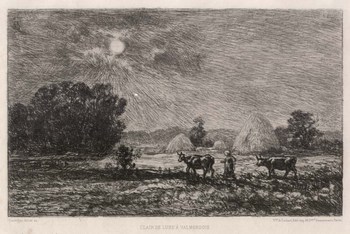 |
|
CLAIR DE LUNE A VALMONDOIS,
1877
Reference: Melot D 127, Delteil ( iv/iv)
This etching was used to illustrate the obituary article on
Daubigny, who died on February 19, 1878. The author, Alfred de
Lostalot, explained that "this etching was drawn two months before
the death of the artist. Daubigny intended to do some retouching -
death did not leave him the time to do so".
Published in the Gazette des Beaux-Arts in 1878, Printed by Cadart
16,50 by 23,50 cm on plate border, with small margins.
Price: 260 EURO
|
|
The
Gazette des Beaux-Arts: The revival of etching as a prominent
form of art first took place in France in the mid nineteenth
century. Sparked by the Paris etchings of Charles Meryon and by the
Barbizon landscape etchings of Charles Francois Daubigny, Millet,
Corot and Jacque, French artists elevated etching to a creative
process of art as vital as painting or sculpture. Such an outburst
of artistic energy in this field had not been seen since the days of
Rembrandt and other seventeenth century Dutch master etchers. At the
vanguard of this wave was the Paris based Gazette des Beaux-Arts.
Beginning with its initial publication in 1859, the Gazette
regularly commissioned the greatest etchers of the day to supply
original graphic art for publication. Nineteenth century editions
included original etchings by Charles Daubigny, Goya, Meryon,
Whistler, Seymour Haden, Max Liebermann, Albert Besnard and others.
Thus some of the greatest etchings of the nineteenth century
originated from this publisher. |
|
Two of
his rare cliché-verre |
|
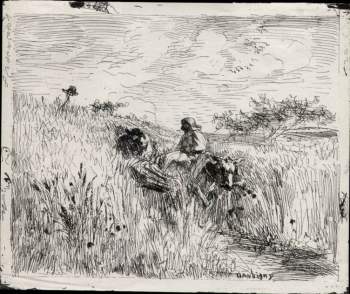 |
|
SENTIER
DANS LES BLES, 1862
PATH IN THE CORN
Early
impressions are extremely scarce
As most of the cliché -verre from the 1921 limited
publication
in Paris by Sagot_Le Garrec
16,50 by 20 cm
on photo sensitive vellum paper.
Price: 550 EURO
|
|
The "cliche-verre"
technique was developed by the painter Constant Dutilleux and one of his
sons-in-law, Charles Desavary, the drawing professor Louis
Grandguillaume, and Adalbert Cuvelier, an industrialist and paint
manufacturer. It was during a trip to Arras on April 16, 1853, to attend
the wedding of Albert Robaut with Elisa Dutilleux, that Camille Corot
discovered the process. Excited by the photographic applications to
drawing and painting, the small group of enthusiasts began a lengthy
collaboration with the painter by photographically reproducing his
paintings. Following these encounters, in May 1853, Camille Corot
produced the first in an impressive series of glass plates. The light,
delicate sensitivity that so often enlivened his landscapes seemed to be
permanently fixed in the lines and hatching of his 'cliche-verre'.The
process momentarily attracted Eugene Delacroix, Charles Daubigny,
Jean-Francois Millet, Theodore Rousseau and many lesser-known artists,
but none used it as enthusiastically as Camille Corot. The history and
technique of the 'cliche-verre' were described in an article in the
November 1903 issue of 'La Gazette des Beaux-Arts'. 'Il s'agit de
dessiner sur une plaque de verre rendue sensible et qui sera ensuite
tiree comme un negatif photographique.On prend une plaque de verre ou de
glace mince recouverte, ordinairement, de collodion sur laquelle on
produit, non pas a l'aide de la chambre noir, mais a la main un dessin.
Simplement griffe avec une pointe de metal ou de bois taille, tamponne
avec une brosse ou un pinceau dur, le verre laisse apparaitre le dessin
original qui, par les transparences et les opacites, devient analogue a
un negatif verre.' 'The prints were made by simple contact, in the same
way as for a normal negative plate. Despite a low margin for
interpretation, considerable differences could appear from one print to
another.The special attraction which distinguishes the cliche-verre from
all other techniques lies in the diversity of printing possibilities.
These variations which are difficult or even impossible to create when
printing an engraving, etching or lithograph, make it possible to
instantly produce a version which is distinct from the original, such as
reversed, transformed or revised version of the artist's original work
It was in
the communities of Arras just outside of Paris and at Barbizon near the
Fountainebleau forest where cliché-verre gained a foothold and briefly
flourished in France over the course of two decades. Jean-Baptiste-Camille
Corot (1796-1875), greatly intrigued by photography, became its most
passionate and prolific practitioner, ultimately attaining fluid, free,
almost abstract sketches which demonstrate his assurance with the medium
and which are striking in their modernity. Corot's extensive visual
exploration with this new medium was enthusiastically shared by
Charles-François Daubigny (1817-1878), whose expertise as an etcher
informed his sensitive and masterful treatment of the glass plate..." |
















